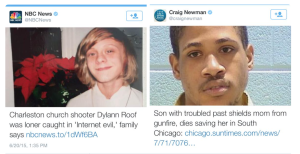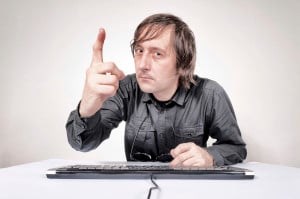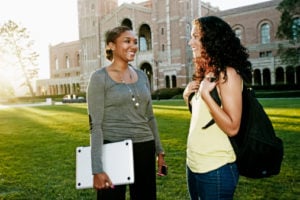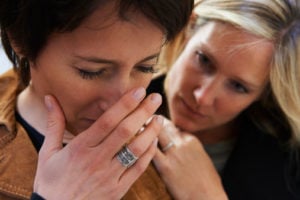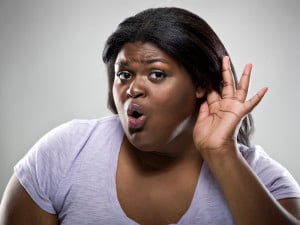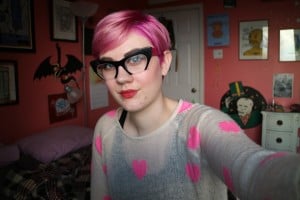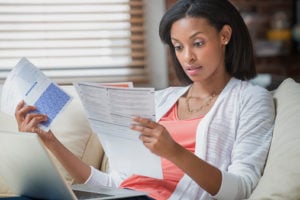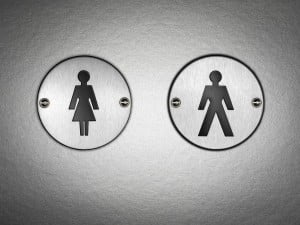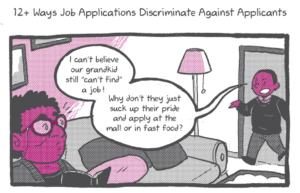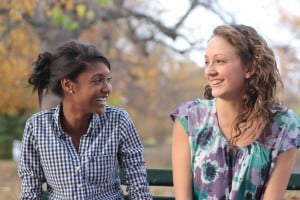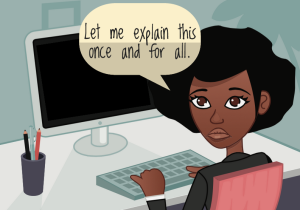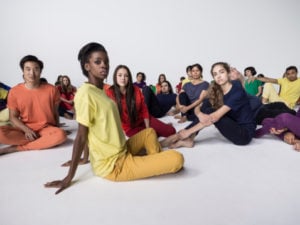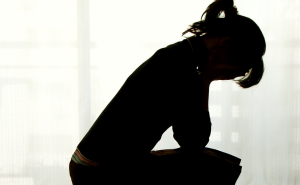Originally published on The Vocal and republished here with the author’s permission.
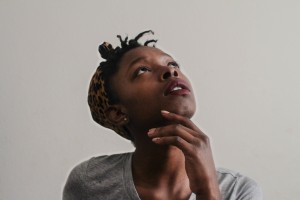
Source: Unsplash
“You’re lucky you’re not attracted to guys.”
My friend was telling me about her boy troubles over drinks one night and kept making presumptuous comments about my sexuality.
“I’m actually bisexual.” I corrected her reluctantly. I had been thinking about telling people for a while, but it felt extremely uncomfortable.
“Oh, okay,” she said. She continued talking about her latest boyfriend and didn’t say anything about my confession.
Two months later, I was watching trashy TV with the same friend.
“OMG, he is so hot” she said, “but I guess you don’t notice that.”
I stared at her, unsure if she was joking. “Remember me telling you I’m bi?”
She shook her head. This happened another three times before it sank in. But in the meantime, another friend did the same thing.
Bisexuality gets treated as a strange, undefined sexual identity – like you are confessing an attraction to unicorns (incidentally, it turns out that unicorn is the Urban Dictionary term for bisexual women willing to join an existing couple, who are apparently regarded as mythical creatures).
It is precisely because of this reaction that I feel it is important to come out. This is why I came out a second time, ten years after my first big announcement.
The first time I came out, aged 19, I did not specify what I was coming out as. I was in a relationship with a woman and people needed to know this life update. I told family and friends, “I’ve fallen in love with a woman,” and let them fill in the blanks.
As a result, people assumed I was a lesbian, and for years I believed I was, not thinking to question the label.
Back in high school, I did not have the words to understand my identity. My school, a religious private school, did not carve out time in the curriculum to discuss sexuality and gender, apart from teaching us technical information about STIs and condoms in sex ed.
Sex education was, and still is, taught by PE teachers, and I wasn’t lucky enough to have PE teachers who were willing to talk about difficult topics like same-sex attraction.
The Internet hadn’t properly worked out who it was, either. So I didn’t have the option of turning to Google as an agony aunt.
I recognized that I had crushes on both boys and girls. I didn’t try to work out what this meant, but I subconsciously censored any mention of my attraction to girls.
My relationship with my partner became serious. I confided about a previous relationship and crushes on boys. I realized that just because my relationship was homosexual, my individual sexuality could be one of a number of identities.
It took time, and a lot of reading about sexuality, for me to work out that I am bisexual.
Once I worked this out, I had to tell my partner. At first, she had concerns about how it would affect our relationship dynamic, as we had come out at the same time and discovered our lesbian identities together.
As I became more comfortable, I tried to make it clear that it meant that I am attracted to people regardless of their gender or sex. This doesn’t mean that I want to be in relationships with numerous people. Over time, she realized it didn’t make any difference and became very supportive about my identity.
Society has been structured around the idea of monosexuality, which is romantic or sexual attraction to only one sex or gender, and monogamy.
Being in a monogamous relationship with a man or a woman does not mean a bisexual person is craving sexual experiences with somebody who has a different gender or sex identity.
Many people think that simply being in a relationship involves aligning oneself as either straight or gay, depending on the sex or gender of our partner.
This is not true. Sexuality is not dependent on who you are currently in a relationship with. Bisexuality is a stand-alone identity.
It is certainly not being “confused” or “greedy,” both things I have heard said.
Bisexuality is not a “gateway to being gay” for all people. People who have read my writing, which refers explicitly to bisexuality, have asked, “Was that before you were ready to come out as a lesbian?”
Some people have sexual experiences with men and women and then make the decision to identify as either lesbian, gay, or straight.
But others don’t fit into the gay-straight binary.
The Importance of Bisexual Visibility
On September 23rd each year, Bisexual Visibility Day is celebrated in certain communities, especially on social media.
This year, Evan Rachel Wood and other celebrities tweeted their thoughts. Mostly, though, it passes without fanfare.
Just over a fortnight later is World Mental Health Day, on October 10th.
It is worth considering the connection there. According to 2014 data from the Australian Bureau of Statistics, almost 50% of all Australians who identified as non-heterosexual identified as bisexual or ‘other’ rather than gay or lesbian.
While gay and lesbian identified people indicated slightly higher levels of discrimination and homelessness, people who identified as bisexual or ‘other’ reported higher numbers of having a mental health condition (38%, compared to 29% for gay and lesbian, and 18% of heterosexual people).
Beyondblue published a report, Going Upstream, aimed at promoting the mental health of lesbian, gay, bisexual, transgender and intersex people. It indicates that homosexual and bisexual Australians report higher levels of anxiety and depression.
The rates of suicide ideation, self-harm and death by suicide are significantly higher in the LGBTQIA+ community, according to data in the report.
What really struck me was that people who identified as bisexual, according to the research in the report, have poorer mental health and experience higher levels of psychological distress than lesbian women and gay men.
Bisexual women were nearly twice as likely to report having been diagnosed with or treated for an anxiety disorder than bisexual men. This data is consistent with international research.
A report published in 2014 by the Australian Human Rights Commission, Face the Facts, shows that more than a third of LGBTQIA+ Australians hide their sexuality or gender identity at work, at events or when accessing services.
There are some obvious reasons for these statistics. LGBTQIA+ people still experience discrimination, harassment and abuse, according to the report, at school, work, and public life.
There is another, insidious factor, that I can’t help but relate to these striking mental health statistics: bisexual erasure. It occurs in both homosexual and heterosexual communities.
There are now lesbian-specific health services and resources, which I see as a positive development. When I came out the first time, these were scarce. I remember being amazed to come across a doctor who treated me respectfully, after some homophobic medical experiences.
But now, identifying as bisexual, I kept noticing that some services neglected to include bisexual women and men.
I also began to notice that many social events are lesbian-specific, not mentioning bisexual or queer women. The term ‘lesbian’ is often used at women-only events, either without thinking or as an intentional, political word choice, which can make participants feel excluded.
I have attended my share of LGBTQIA+ community events, both in Australia and overseas, where bisexual women and men are not specifically welcomed or included.
Outside the queer community, I noticed that many straight women act strangely around lesbian or bisexual women. I’m not sure whether this is because they are scared we might kiss them or because they make negative assumptions about us.
Straight women talk freely about their attraction to men, and lesbians discuss their attraction to women. While, as a bisexual woman, I feel excluded but also uncomfortable at the idea of joining in.
Straight men seem to be titillated (no pun intended) by our identity, as bisexuality is often associated with threesomes.
My bisexual friends who are in “straight-appearing” relationships feel that their bisexuality is invisible and something they shouldn’t talk about. If they do talk about it, they are seen as being provocative or having “straight-passing privilege.”
Passive discrimination is just as problematic. I have heard strangers and new acquaintances make offensive or hurtful remarks about sexuality, employing bias, stereotypes and assumptions that make me feel abnormal, deficient or defective.
I strongly believe in sexuality as a continuum.
Rather than people being 100% heterosexual or homosexual, and some a 50:50 mix (a ratio people often mistakenly apply to bisexuals), some people are simply higher on the Kinsey scale than others, as Alex told Piper in the latest season of Orange is the New Black.
Apart from bisexuality, there are people who identify as pansexual, omnisexual and non-monosexual, and those who experience sexual fluidity.
Sexual fluidity describes the way that sexual responses can change throughout one’s lifetime, separate to sexual orientation. This can go either way, from someone who always identified as straight suddenly experiencing same-sex attraction, and vice-versa.
Researcher Lisa Diamond indicated that more women than men experience sexual fluidity, especially as they get older. However, recent research suggests that men are more sexually fluid than previously thought.
There are also people who don’t feel that they fit into any labels, or choose to disregard the set definition of a particular label or identity.
I recognize that all of this is related to social constructs and perspectives on gender and sexuality that some might argue are out-dated.
Some people tell me that “queer people are accepted now” and think that conversations on these topics are no longer necessary.
This is dangerously wrong.
We all want to belong to some extent. I choose to identify as “queer” as I find it a more inclusive term for the LGBTQIA+ community.
It is unfortunate that the “B,” “T,” I,” and “A” are left out all too often.
How to Be a Better Ally
I used to hate coming out as bisexual. Now, knowing the significantly worse mental health implications for bisexual or non-monosexual people, I feel it is important for me to be honest and visible for those who can’t.
So, here are some ways that we as a society can do better than a one-off, annual Bisexuality Awareness Day:
1. Increase awareness of bisexuality, or non-monosexuality, as a valid sexual identity.
Speak up when people make assumptions or judgements.
Actively combat negative tropes about bisexuals, in particular the automatic associations with cheating, promiscuity, threesomes, an inability to commit, going through “a phase” or being too cowardly to come out fully.
2. Remember that all of us benefit from sexual and gender diversity.
The idea of enforced monosexuality, or only being allowed to be attracted to one sex or gender, can be quite damaging.
It traps people into stereotypical practices and behaviors based on very traditional ideas of only being attracted to one sex/gender.
3. Don’t make assumptions based on whom people marry.
A lot of people having same-sex or straight marriage ceremonies are actually bisexual.
Remember Anna Paquin schooling Larry King when he asked if she was now a “non-practising bisexual” after marrying Stephen Moyer?
4. Don’t assume you know how the entire community feels about an issue and attempt to speak for everyone.
Even if you have LGBTQIA+ friends or family, or are LGBTQIA+ yourself, we are a diverse community.
Being, or knowing, one letter in the LGBTQIA+ alphabet does not mean you understand everyone under the queer umbrella.
5. Learn the terminology.
Don’t call me a lesbian just because I am married to a woman.
Again, listen and use the terms that people identify with, not the terms you think they should identify with.
Applying the incorrect terminology of lesbian or gay to a bisexual person can force us back in a closet.
Remember, though, that this might change. Someone who identifies as monosexual at first may later realize they are bisexual, or vice-versa.
6. Make it easier for everyone in the acronym LGBTQIA+ to come out.
Remember those statistics that showed that LGBTQIA+ people hide who they are at events, school or in the workplace?
Don’t assume you know somebody’s sexuality or gender based on their partner’s identity. Ask open questions and be supportive.
7. Read about and experience life that is outside your experience.
Books about, or by, LGBTQIA+ people are not included or promoted in mainstream media, publications and commercial avenues.
Find books about people whose identities are different to yours. If these books are not in your library or bookshop, request them.
See films about LGBTQIA+ people, like Freeheld (making exceptions for those that whitewash LGBTQIA+ stories and ignore intersectional issues like race, such as Stonewall).
8. There’s more to being an ally than being pro same-sex-marriage.
By all means, continue to post rainbow profile pictures on Facebook and share articles about marriage equality.
But also engage in some LGBTQIA+ activism that is not about marriage, such as reducing homelessness or improving mental health.
You can do this by following social media accounts of a range of LGBTQIA+ organisations, not just Marriage Equality groups.
9. Stop assessing celebrities’ sexuality or gender identity.
If celebrities say they are bisexual, pansexual or queer, let’s stop deciding they aren’t. It doesn’t matter if they date men or women.
Sometimes, celebrities go a bit too far and say, “It was a phase,” which never goes down well with bisexual or queer people, but ultimately it is up to them.
Eventually, we won’t have to come out, and the more sexually fluid won’t have to live their lives one way, change and get mistreated.
10. Call out for more research and societal engagement with the concepts of sexual diversity, fluidity and the continuum.
Read and share what you come across with people. You never know who it might help.
***
So why do I need to share my identity?
I am quite fortunate in many ways. My partner is supportive of my identity.
Also, because I am in a lesbian relationship, I belong to the queer community automatically. I am visibly queer and only have to bring up bisexuality if the assumptions are becoming too much to handle.
But I think of bisexual, or non-monosexual, people in straight-read relationships, who are assumed to be 100% heterosexual, and I worry for them.
These suggestions are to help you make life easier for those who may be silently struggling.
In your lifetime, you might find yourself attracted to someone whose sexuality or gender doesn’t tick the box you expected. It may or may not shake up your world and your sense of your sexual orientation.
A world that sticks to black and white, gay and straight – an oppressive, restrictive world that looks a lot like Pleasantville – shuts down dialogue and teaches people that there is no ambiguity or flexibility around sexuality, gender and identity.
And if even one of these things had been said back in my school PE classes, the next decade of my life would have been a lot easier.
Search our 3000+ articles!
Read our articles about:
Our online racial justice training
Used by hundreds of universities, non-profits, and businesses.
Click to learn more
Most Read Articles
- « Previous
- 1
- …
- 30
- 31
- 32





